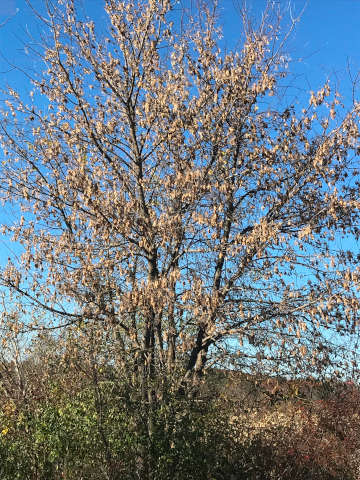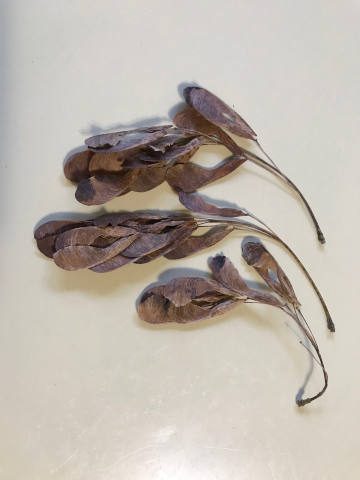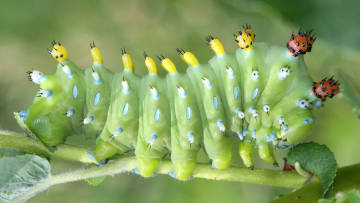Nature Notes

Boxelder tree in late fall
November 9, 2025
NATURE NOTES
By Annie Reid
Westborough Community Land Trust
Boxelder: a different maple
Decades ago, all the leaves were down by Halloween. Not so these days. In early November, some trees not only have leaves but also still show color. Thanks to climate change – perhaps the usual decreasing fall daylight, but now with less cold weather? In any case, when fall’s show is over, and most oaks have shed their leaves, what can we look for during a walk in our local natural environment? One possibility is a native tree that many people may not have heard of: the boxelder (Acer negundo). It’s a kind of maple. In a leafless landscape, boxelders become obvious due to their abundant drooping, dried seeds that last through winter.
You might spot a boxelder at a distance, decked out in its clusters of brown seeds. If you get close, you might notice that its seeds resemble maple seeds. Each seed has a wing, and the seeds are often in pairs. Surprisingly, the boxelder is, indeed, a maple (Acer).

Boxelder seeds last on the tree through winter, making the tree obvious in a leafless landscape.
The seeds might tell you that it’s a maple, but you’d never guess from the boxelder’s leaves, now littering the ground. They’re like ash leaves, so much so that another name for the boxelder tree is “ash-leaved maple.” Boxelder leaves are made up of three to five separate, pointed leaflets (sometimes seven), very different from the single, lobed leaves of other maples. As the name boxelder might suggest, there’s also a similarity to elder or elderberry leaves (Sambucus nigra canadensis).

Clusters of boxelder seeds
Boxelders thrive in full sun, so look for them along trails or old farm roads around fields (as in fields north of Westborough’s Lake Chauncy) or in other open areas. Native to North America east of the Rockies, these adaptable trees grow naturally from coast to coast. In some areas, they have been widely planted as street trees or shade trees, or as windbreaks on farms or in yards. At least nine cultivars have been developed for landscaping.
What else about boxelder says “maple”? Its sap is slightly sweet, though less sweet than the sap of sugar maples (Acer saccharum) or red maples (Acer rubrum), both used to make maple syrup. Plains Indians (of the Great Plains) made sugar from boxelder sap, and settlers used the sap to make maple syrup. Even today, some people tap boxelder trees and boil down the sap to make maple syrup. Reports suggest that it takes 60 or 70 gallons of boxelder sap to make one gallon of syrup, as compared with 40 gallons of sugar maple sap for one gallon of syrup.

Drying boxelder leaves, composed of 3 to 5 leaflets. They turn yellow in autumn.
If you look for boxelder trees, what else might be helpful to know? They are medium-sized trees, growing 30-60 feet tall. They may have a short main trunk with a round but uneven crown, especially in the case of a cultivated variety. A wild boxelder might seem more unruly, with several trunks and twisting or drooping branches. Boxelder wood is weaker than typical maple wood, known for its strength. The “box” in its name may come from the use of the wood for boxes.
Boxelders bloom early, in March-April, and are wind-pollinated, like other maples. But unlike other maples, boxelders have separate male and female flowers, and these occur on separate trees. The flowers look quite similar, so you can’t easily tell from the flowers whether a tree is “male” or “female.” But you know the seed-bearing boxelders spotted at this time of year are “female” trees, because seeds develop only from female flowers.
The seeds are food for wildlife, especially in late winter or early spring when there’s little else. Birds with strong beaks, such as evening grosbeaks and pine grosbeaks (Pinicola enucleator) easily deal with the tough seed casings. Squirrels and chipmunks do so as well. There’s no nectar at boxelders, but bees collect pollen (for food) from the flowers in spring.
As a native tree, boxelders are a source of food or shelter for many native moths and other native insects in parts of their lifecycles. For example, the rosy maple moth (Dryocampa rubicunda) and the cecropia moth (Hyalophora cecropia) lay eggs on maples, including boxelders. Their caterpillars feed on green leaves when they hatch (and eventually overwinter in cocoons). Insects, in turn, are important food for birds and other animals.

PHOTO COURTESY OF GARRY KESSLER
The rosy maple moth (close-up side view) lays eggs on maples including boxelders, and then its caterpillars feed on leaves.
Boxelders favor moist soil, so you’ll often find them near water, along ponds and streams. These trees are successful in a range of soils and environments. They are tolerant of wet soil, cold, and drought. They grow fast, and come up both from seed and from suckers. They’re relatively short-lived (75 years).

PHOTO COURTESY OF GARRY KESSLER
The caterpillar of the cecropia moth feeds on leaves of maples including boxelders.
The success of boxelders can make them seem “weedy.” Not everyone is a fan. With lots of seeds and weak wood, these trees are sometimes regarded as messy. Homeowners may be advised to plant “male” trees, which don’t have seeds to shed.
As you view the late fall landscape, you (or observant youngsters) might also notice dead leaves on a couple of other trees. Young American beech trees and certain young oaks tend to keep their dead leaves into winter.
This season, whether you see a boxelder or not, be glad for the diversity of our local forests. Let the boxelders’ long-lasting seeds remind you of the interdependence of living things in nature, and the challenges of winter survival in New England.
Date index
Month (November)
Common name index
Scientific name index
Category index